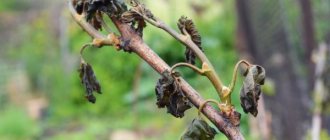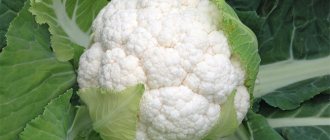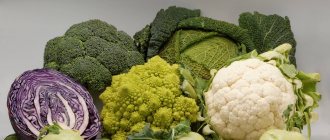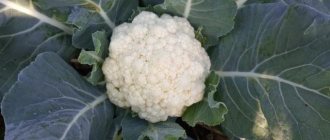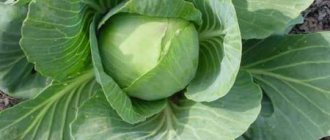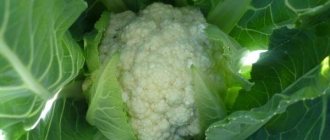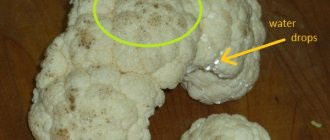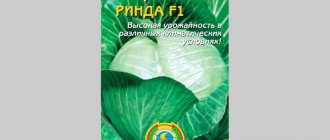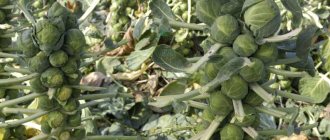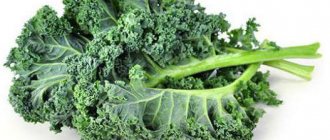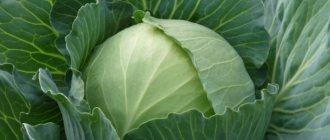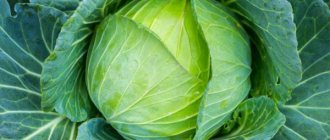Cauliflower is a finicky vegetable. Growing it is not so easy, and getting a good harvest is even more difficult. For most gardeners, it remains a mystery when to remove cauliflower from the garden. Focusing only on the information about the ripening period available on the bag of seeds, it is easy to get into trouble. The fact is that the growing season is influenced by many factors, so the timing of harvesting may shift. It is important to learn how to determine the degree of maturity of the heads by external signs.
Cauliflower
Rules for harvesting cauliflower
The main requirement that will help preserve the harvest of this vegetable, which is not prone to winter storage, for as long as possible is maximum cleanliness. Everything that will touch the plant during its removal from the garden must be dry, not previously used or treated with disinfectant solutions. The knife is sterilized over an open fire.
Withering of the lower leaves
During harvesting, 4-5 lower leaves are left so that they protect the edible part from mechanical damage and contamination. Having cut off the head from the stem, under no circumstances should it be placed on the ground or vegetation cover. It is best to lay the stalks on a clean, dry film for several hours to wilt the leaves.
In this state, the cabbage will not begin to rot longer. This should be done either under the sliding rays of the evening sun, or under a canopy. The weather should be dry.
They are not in a hurry to cut heads of cabbage if it rained the day before. It is very bad if prolonged rains begin. If it is necessary to harvest crops in such conditions, they do not delay canning the fruits of their labor.
Cabbage requires cleanliness
How to cut?
For harvesting cauliflower, the ideal tools are well-sharpened kitchen knives. Alternatively, small sharpened axes can be a good choice, but in this case there are problems with cutting the required number of stems.
When to harvest cabbage from the garden in the fall:
In order not to damage the vegetable with your nails, it is customary to use gardening gloves.
After harvesting cauliflower, vegetables must be immediately removed away from direct sunlight. This allows you to protect cauliflower from premature spoilage and prolong its presentation.
Storage methods
If the garden or vegetable plot is located far from housing and there is a danger that the plant will be overtaken by severe frosts, the cauliflower is harvested, but almost all of it is canned immediately.
A small portion is stored in the refrigerator, placed in a paper bag. Several especially healthy heads, which are planned to be quickly eaten, are wrapped in cling film.
In the basement
It is most convenient to store cabbage in a specially prepared basement. Among the measures for disinfecting the premises, whitewashing with quicklime and fumigation with sulfur are used.
After these procedures, the basement is thoroughly ventilated, remembering that during the combustion process not only toxic gases are released, but oxygen also burns out. Therefore, you should not rush to enter the premises without making sure of your complete safety.
- Plastic boxes are wiped with a disinfectant solution, wooden boxes are fumigated with fire smoke.
- Next, cut cauliflower stalks are loaded into the cellar.
- They are placed in boxes lined with paper or a clean cloth, preferably in one layer.
Cauliflower is ready for storage
Another storage method: hang by the stems in the same cellar or in another cold room not subject to freezing. The best temperature to prevent the development of harmful organisms is approximately 0 °C. Air humidity is 90-95%. You need to quickly lower the temperature in the cellar by ventilating in the event of the next frost.
Growing up
The longest segment in the cabbage growing season ends with the beginning of tying the heads. The edible part can be ready in 2-3 weeks. Naturally, it is a shame and unreasonable to destroy the plant at this stage due to the autumn cold snap.
Note! It is practiced to dig up healthy, well-developed stems along with roots and leaves and grow the heads in a cellar or greenhouse. The more magnificent the leaves, the better, since they, knowing that their period has expired, will give their nutrients to the fruit.
In the cellar, plants are buried up to the leaves in boxes covered with damp soil. If light leaks from somewhere, cover the cabbage with a dark film. As a result, the head of cabbage can increase one and a half times and will not rot, which is also important, given the difficulty of long-term storage of this vegetable.
Growing with roots
How to determine the timing of harvesting?
The timing of the start of harvesting depends on the characteristics of the variety. Cauliflower, like other garden crops, can be early, mid-season and late. When buying seeds, it is important to pay attention to the description of the variety. Crop ripening time depending on variety:
- Early ripe cauliflower reaches maturity within 70–90 days from the moment of germination, that is, you can enjoy it as early as June.
- The ripening period for mid-season varieties is 95–130 days.
- Late cauliflower is ready for harvesting from the garden 4–5 months after the appearance of friendly shoots. It is cut from late August to mid-September.
Vegetable growers with experience in growing this crop use information about the characteristics of the variety only as a guide regarding sowing dates. They do not wait until the cauliflower heads reach 2-3 kg, as manufacturers claim, but start cutting the inflorescences earlier. The heads are ready for harvesting when their diameter reaches 10–12 cm.
The influence of external factors on the ripening of cauliflower
Real ripening dates do not always coincide with information about the characteristics of the variety, so you should not rely on them. Let's consider the factors that influence the growing season, accelerating or slowing it down:
- Air temperature. Cauliflower develops correctly when the thermometer readings range from +15 to +25 degrees. If the weather is cool, the process of inflorescence formation slows down. At high temperatures, the heads quickly fade into color.
- Insufficient watering. Cauliflower is a moisture-loving crop. Lack of moisture in the soil leads to the formation of small and loose inflorescences.
- Lighting level. Experienced gardeners recommend shading the knotted heads from the sun. Artificially reducing the length of daylight hours will allow you to grow strong and juicy inflorescences.
- Lack of nutrients in the soil. On poor soil, cauliflower does not bear fruit well - the heads form late, and their size and structure leave much to be desired.
Time to harvest
If from the beginning of the season you have properly cared for your vitamin plantings, then in the middle of summer you will receive a well-deserved reward - a lot of dense, snow-white (or purple, orange, emerald) inflorescences. And now the main task is to collect what has been grown on time and preserve the harvest for as long as possible. The timing of harvesting primarily depends on the characteristics of the selected variety.
- Early cabbage will form full-fledged inflorescences in 2–3 months. Thus, the first fruits can be tasted at the end of June - beginning of July.
- Mid-season varieties require an active growing season lasting from 100 to 130 days. They will decorate the garden with cabbage “bouquets” in the second half of summer.
- Late varieties will delight you with a bountiful harvest only at the end of August or September, since they require at least 5 months to grow and develop. But such cabbage will be stored much longer than its earlier relatives.
Experienced gardeners know that stated ripening dates do not always coincide with actual ones. After all, the growing season is influenced by many factors.
- The optimal temperature for timely ripening should be in the range from +15 to +20° C. At lower values, plant growth slows down significantly, and too warm air (above +25°) leads to the formation of defective (small and loose) inflorescences.
- A lack of moisture in the soil can lead to sad results. With a lack of water, heads that are too small and not dense enough are formed.
- Cauliflower is very sensitive to light levels. With an excess of sunlight, inflorescences not only form too quickly, but also tend to grow. To prevent this from happening, during long daylight hours it is recommended to shade the barely formed heads.
- The intensity of development and fruiting of plants depends significantly on the fertility of the soil, including the content of necessary micro- and macroelements in it. On poor soils, cabbage develops more slowly and later forms inflorescences, which rot very quickly.
Preparing for storage at home
Properly collected cabbage heads are suitable for storage . They are harvested during the growing period, preventing the crop from becoming overripe. The heads should weigh between 0.3-1.2 kg.
If the fork is crumbly, yellow in color, does not hold its shape and is limp, it is not suitable for long-term storage. A vegetable that has outgrown the harvest time loses a significant part of its nutrients.
Cabbage is harvested in dry weather. The cut inflorescences should be immediately transferred to the shade so that they do not begin to wither.
- Remove dense stalks.
- Remove outer yellowed leaves.
- If there are sprouted leaves, they are removed.
- Rinse.
- Dry.
Ripening time by variety
Cauliflower is a rather finicky crop, the cultivation of which requires special knowledge, effort and a certain amount of time. But even if the growing stage is successfully brought to perfection, proper and timely cleaning remains important.
What frosts can cabbage withstand? Is the vegetable afraid of frost?
When is it better to chop cabbage for the winter: before or after frost? Many varieties of cabbage are frost-resistant, which means they are not afraid of frost. But in order for cabbage to retain its ability to be stored for a long time without losing its freshness, its exposure to low temperatures during its stay in the garden should be short-lived.
Harvesting cabbage from under the snow at temperatures below -6 degrees has a negative effect on all varieties of cabbage, as does repeated frosts after thawing. When thawed, the outer cabbage leaves become home to microscopic organisms that cause rotting of the crop.
Cut heads of cabbage cannot be left outside at sub-zero temperatures; their long-term storage will then be impossible.
What frosts can cabbage withstand in the fall? Cabbage, as a rule, tolerates the first temperature fluctuations below zero without problems.
Light frost even has a positive effect on the taste of this vegetable: a sweetish taste appears.
The maximum sub-zero temperature that cabbage can withstand is minus 6 degrees Celsius, provided that the thermometer does not stay at this mark for a long time.
What frosts can late varieties of cabbage withstand? Late-ripening varieties are also called mature varieties. In order not to deprive them of their “keeping quality” (long shelf life), they should not be exposed to temperatures below 6 degrees Celsius.
And for cut late-ripening heads of cabbage, even -1 will be a great tragedy: on the sections, the tissue of the stalks is exposed and freezes very quickly, which subsequently starts the processes of rotting.
Sauerkraut is usually made from heads of cabbage that have been exposed to temperatures as low as -4 degrees Celsius during their growth.
Is Chinese cabbage afraid of frost? Chinese (Peking) cabbage is frost-resistant, but after freezing below -4 degrees Celsius it begins to rot. It is not recommended to expose Chinese cabbage to temperatures below -2 degrees Celsius. It is collected around October 15, when there are no permanent frosts. You can learn about ways to store Chinese cabbage from our article.
Which cabbage tolerates frost well? Frost-resistant cabbage varieties labeled F1: “Katyusha”, Russian Winter”, “Ulyana”. “Lika”, “Yaroslavna”, “Sugarloaf”, “Ukrainian Autumn”, “Zimovka”, “Amager 611”, “Snow White”, “Violanta” and “Kharkovskaya Zimnyaya” also tolerate frost well.
What to do if cabbage is frozen? The heads of cabbage should thaw without being cut. This usually takes 4 - 5 days, after which the cabbage can be cut and sent for the winter.
Is it possible to harvest cabbage after freezing? Immediately after freezing, cabbage cannot be stored for storage. If you do not wait a few days until the cabbage thaws on the root, it will begin to rot in the first month after harvesting: black leaves will appear.
